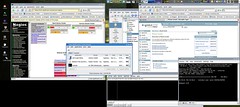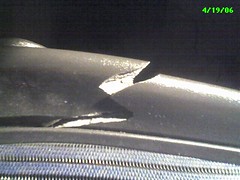The Continued Improvement of KDE
I’ve written before about the fairly detailed advances that have been occurring in the KDE desktop environment. This past week I got a chance to test out a few more, and for me the environment gets better and better with each passing week.
USB Device Support
One could argue this is better attributable to Kernel level and OS-level improvements, but history has seen that desktop enhancements often lag far behind kernel and OS changes. In this case, they’re moving forward hand in hand.
I use several ‘external’ USB devices that I connect to either yawl or to hunter. These consist of any of the following:
- A 256 meg pen drive (used for ‘hot’ backups of databases while at events)
- A generic 190gig external USB drive for backups and general storage
- an Olympus C-770 camera
- A Palm Treo-650
- An Apple iPod
Traditionally, using ‘removable’ filesystem devices under Linux would involve much finagling of automounting device confifgurations, as well as the ‘Pray and Pull’ approach to disconnection. It might disconnect cleanly, it might not.
 With the switch to devfs in the 2.6 Linux kernel, USB devices are mounted and unmounted automatically upon detection. I have been able, without doing any filesystem tuning, to simply jack in any of the above devices, and both of my machines mount the device immediately. Under KDE, the devices even show up on the desktop as an active icon, and I’ve configured KDE to automatically open the device in a file browse window upon detection. This makes moving pictures and other items on and off the drives a breeze. A simple drag and drop. For camera operations, this is sufficient, but read on for considerations for other devices.
With the switch to devfs in the 2.6 Linux kernel, USB devices are mounted and unmounted automatically upon detection. I have been able, without doing any filesystem tuning, to simply jack in any of the above devices, and both of my machines mount the device immediately. Under KDE, the devices even show up on the desktop as an active icon, and I’ve configured KDE to automatically open the device in a file browse window upon detection. This makes moving pictures and other items on and off the drives a breeze. A simple drag and drop. For camera operations, this is sufficient, but read on for considerations for other devices.
iPod support in Amarok
The Apple iPod is an unusual device. It does function as a USB drive, and shows up on the filesystem with appropriate file structures and the like, but it’s really not meant to be manipulated as a filesystem directly. Music is stored in ‘numbered’ directories, with cryptic names on each. Not very helpful when simply browsing with a filesystem view. Fortunately, some bright lights have come up with a great interim system.
I had originally been using GTKPod as a tool for working with the iPod, but I found the interface less than intuitive, and it didn’t integrate well with the rest of my desktop. It was a typical standalone Gnome app, with only the faintest nods to the concept of desktop interaction and interface sharing.
 When confronted with “Hm how am I going to sync my music collection to my iPod”, I noticed in the Amarok window a selection for ‘media devices’. And sure enough, in there, there was the iPod, available for synchronizing. I went through my already selected playlists (I use Amarok constantly), selected a handful of new songs, and said “Add these to media device queue”. Once they were all set, I simply clicked “Synchronize”, and the system connected up to the iPod properly, synced the music over to it, and shut down cleanly. Total time, about 8 seconds.
When confronted with “Hm how am I going to sync my music collection to my iPod”, I noticed in the Amarok window a selection for ‘media devices’. And sure enough, in there, there was the iPod, available for synchronizing. I went through my already selected playlists (I use Amarok constantly), selected a handful of new songs, and said “Add these to media device queue”. Once they were all set, I simply clicked “Synchronize”, and the system connected up to the iPod properly, synced the music over to it, and shut down cleanly. Total time, about 8 seconds.
My understanding is this is similar to how iTunes works (I’ve only run it briefly – my exposure to it under Windows only brought up feelings of ‘bulky, slow, unintuitive, and not native. Looks like an Apple port’, and after that I didn’t bother. With Amarok, I’m using my own music collection via a tool that is an absolute joy to use (Amarok). The iPod synchronizing is just icing on the cake, but a pleasant find nonetheless.
A good desktop
All in all, the KDE desktop simply continues to improve and improve and improve more. Yes, some of these functions are things that others have been doing for a while. But when was the last time anything really revolutionary was done in the desktop environment? The gap between the ‘stable, consistent Windows desktop’, the ‘warm and fuzzy and friendly mac desktop’, and the opensource rogue of KDE is far narrower than many would say. At the moment, I’d put the useability, capability, and flexibility of KDE over the Mac, and in many ways, far over Windows as well.





 I think it’s a sign of the apocalypse. In the space of about 15 minutes, I not only smoked a video board (no, didn’t toke it up… it literally started smouldering while installed in the machine. The fan bearing had failed on the cooler), not only crashed said XP box right in the middle of getting information i was looking for, but in a fit of excitement, I apparently broke the seat of my nice Size C Aeron chair.
I think it’s a sign of the apocalypse. In the space of about 15 minutes, I not only smoked a video board (no, didn’t toke it up… it literally started smouldering while installed in the machine. The fan bearing had failed on the cooler), not only crashed said XP box right in the middle of getting information i was looking for, but in a fit of excitement, I apparently broke the seat of my nice Size C Aeron chair.